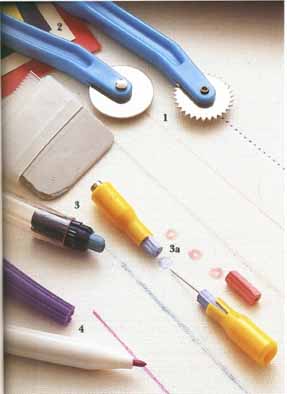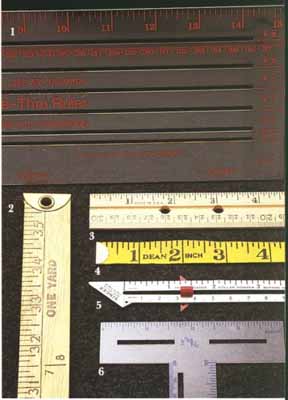Marking Tools
The symbols on a pattern piece are guides for the accurate construction of the garment. Transferring these symbols from pattern to fabric is essential to fitting and sewing. Because you will be working with several types of fabrics, you will need a variety of marking tools.
1) Tracing wheels come in two types: serrated or smooth edge. The serrated edge makes a dotted line marking. It is suitable for most fabrics but may pierce delicate ones. The smooth-edge tracing wheel protects delicate, smooth fabrics such as silk and chiffon. It makes a solid line marking.
2) Dressmaker’s tracing paper is a special waxed carbon paper which transfers the tracing wheel’s line to the fabric. Choose a color close to that of the fabric, making sure it can be seen easily.
3) Tailor’s chalk or marking pencil marks quickly and easily, directly on the fabric. Chalk rubs off quickly, so use it only when you plan to sew immediately. A tailor tacker (3a) holds two pieces of chalk and marks from both sides.
4) Liquid marking pencils make quick work of marking tucks, darts, pleats and pocket locations. One type disappears within 48 hours. The other washes off with water but should not be used on fabrics that show water marks. Pressing may set the marks permanently, so remove marking before pressing the area.

Measuring Tools
Body and pattern measurements both require measuring tools. To ensure a good fit, measure often and accurately with the best tool for the job.
1) See-through ruler lets you see what you measure or mark. This ruler is used to check fabric grainline and to mark buttonholes, tucks, and pleats.
2) Yardstick is for general marking and for measuring fabric grainline when laying out the pattern. It should be made of smooth, shellacked hardwood or metal.
3) Ruler is for general marking. The most useful sizes are 12" or 18" (30.5 or 46 cm) long.
4) Tape measure has the flexibility required to take body measurements. Select a 60" (152.5 cm) long tape with metal tips, made of a material that will not stretch. It should be reversible, with numbers and markings printed on both sides.
5) Seam gauge helps make quick, accurate measurements for hems, buttonholes, scallops, and pleats. It is a small, 6" (15 cm) metal or plastic ruler with a sliding marker.
6) See-through T-square is used to locate cross grains, alter patterns, and square off straight edges.



